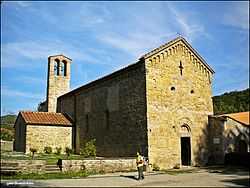Vernio
| Vernio | ||
|---|---|---|
| Comune | ||
| Comune di Vernio | ||
 | ||
| ||
 Vernio | ||
| Coordinates: 44°3′N 11°9′E / 44.050°N 11.150°E | ||
| Country | Italy | |
| Region | Tuscany | |
| Province | Prato (PO) | |
| Frazioni | Cavarzano, Costozze, Le Confina, Mercatale Vernio, Montepiano, Risubbiani, San Quirico (communal capital), Sant'Ippolito, Sasseta, Terrigoli | |
| Government | ||
| • Mayor | Paolo Cecconi | |
| Area | ||
| • Total | 63.3 km2 (24.4 sq mi) | |
| Elevation | 278 m (912 ft) | |
| Population (31 August 2007)[1] | ||
| • Total | 5,938 | |
| • Density | 94/km2 (240/sq mi) | |
| Demonym | Verniatti | |
| Time zone | CET (UTC+1) | |
| • Summer (DST) | CEST (UTC+2) | |
| Postal code | 59024 | |
| Dialing code | 0574 | |
| Patron saint | St. Leonard of Noblac | |
| Saint day | 6 November | |


Vernio is a comune (municipality) in the Province of Prato in the Italian region Tuscany, located about 30 km northwest of Florence and about 20 km north of Prato, with a pupulation of 6.095.
History
Vernio's name derives from that of an ancient Roman winter camp (castra hiberna) located here. A Roman bridge existed in the area, but was destroyed during World War II. In the 12th century it went from the Carolingians to the counts Alberti from Prato, who lived here after 1107. In the 13th century it went to the Bardi family, as the seat of a county which remained independent until 1798, when it was abolished by Napoleon. After the Congress of Vienna it was annexed to the Grand Duchy of Tuscany.
Geography
Vernio borders the following municipalities: Barberino di Mugello, Camugnano, Cantagallo, Castiglione dei Pepoli.
The municipality of Vernio is union of 3 villages:
- San Quirico (with the town hall)
- Mercatale with the Vernio-Cantagallo-Montepiano train station
- Sant 'Ippolito (with a nice parish church)
Villages
- Cavarzano
- Celle di Vernio
- Ceraio
- Costozze
- Gavazzoli
- Gorandaccio
- La Rocca di Vernio
- La Storaia
- La Valle di Vernio
- Le Confina
- Luciana di Verrio
- Mercatale Di Vernio
- Montepiano
- Poggiole
- San Quirico di Vernio
- Sant'Ippolito di Vernio
- Sasseta
- Segalari
- Terrigoli
Main sights
The main sight is the Abbey of Santa Maria (11th century), at Montepiano, housing 13th-century frescoes.
Churches
- Montepiano abbey
- Sant'Agata chapel in La Rocca
- Ex oratory of the company of Jesus in Sant'Ippolito
- Madonna della Neve in Sasseta
- San Pietro in Cavarzano
- Santuario di Sant'Antonio Maria Pucci
- San Bartolomeo in Costozze
- San Martino in Luciana
- San Michele in Sasseta
- San Niccolò oratory in San Quirico
- San Quirico e Leonardo in San Quirico
- Sant'Antonio da Padova in Mercatale
- Sant'Ippolito e Cassiano in Sant'Ippolito
- Santa Maria in Montepiano
Nature
- La Torricella
- Alpe in cavarzano
Feasts
- Feast of polenta San Quirico, 26 February
- Carnival in Sant'Ippolito Sant'Ippolito, 22 February
- San Giuseppe feast San Quirico, May
- Madonna delle Neve feast in Sasseta, August
- Rificolona fest in Montepiano, August
- Commemoration of the threshing of the wheat and spelled in cavarzano, 31 July
- Montepiano Country, 23 July
Twin towns
References
External links
![]() Media related to Vernio at Wikimedia Commons
Media related to Vernio at Wikimedia Commons
